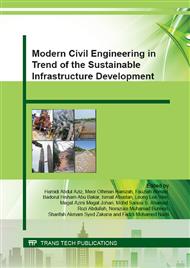p.277
p.283
p.290
p.295
p.303
p.309
p.315
p.321
p.327
Behavior of Cold Recycled Mixes in the Range of Low Temperatures – Experimental Study
Abstract:
Cold recycled mixes are used in many parts of the world as a standardized pavement rehabilitation technique. The quality of the mixes has been so far assessed by strength characteristics, water susceptibility and stiffness. In some cases frost resistance is determined as well. Nevertheless, especially for regions with winter seasons where temperatures are reaching values below 0°C, there are no standardized procedures and sufficient findings related to resistance to cracking and fracture behavior. Experimental study done at CTU in Prague describes three types of tests performed on 15 different cold recycled mixes. In parallel three standardized hot asphalt mixes were selected and used as well for a comparison of behavior in the range of low temperatures. Finally specimens acquired from an existing construction site where cold recycled technology was applied have been cored and tested mainly for crack propagation test. In general three tests have been selected and include crack propagation text on semi-cylindrical specimens, flexural strength test and relaxation test. Behavior in low temperature range and resistance to cracking has been tested in the temperature range of 0°C to-10°C.
Info:
Periodical:
Pages:
303-308
Citation:
Online since:
October 2015
Authors:
Price:
Сopyright:
© 2015 Trans Tech Publications Ltd. All Rights Reserved
Share:
Citation:


